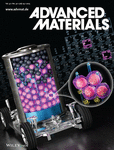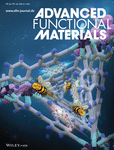Journal list menu
Export Citations
Download PDFs
Full Papers
Selective Adsorption of Co(II) by Mesoporous Silica SBA-15-Supported Surface Ion Imprinted Polymer: Kinetics, Isotherms, and Thermodynamics Studies
- Pages: 387-398
- First Published: 28 March 2011

A novel surface ion imprinted adsorbent [Co(II)-IIP] using polyethyleneimine (PEI) as function monomer and ordered mesoporous silica SBA-15 as support matrix was prepared for Co(II) analysis with high selectivity. It was found that the pseudo-second- order model best correlated the kinetic data. Co(II) adsorption onto IIP was controlled by the intraparticle diffusion mechanism, along with a considerable film diffusion contribution. Langmuir model fitted the experiment data well and the maximum calculated capacity of Co(II) reached 39.26 mg/g under room temperature. Co(II)-IIP showed high affinity and selectivity for template ion compared with non imprinted polymer (NIP).
Photocatalytic Reduction of Nitro Compounds Using TiO2 Photocatalyst by UV and Vis Dye-sensitized Systems
- Pages: 399-404
- First Published: 28 March 2011

In the dye-sensitized system, the dye, rather than the TiO2 photocatalyst, absorbs visible light and is excited. The photoexcited electron injection from the excited dye molecule to the conduction band of TiO2 generates dye radical. The dye radical can selectively oxidize the alcohols to aldehydes, and it was reduced to dye. The process achieves the cycle of dye and the dye radical. The photoexcited electrons are strong enough to reduce aromatic nitro-compounds adsorbed on the surface of TiO2 to aromatic amino-compounds.
Aggregation Behaviors of Tricarbocyanine Dye in Water and in AOT Reverse Micelles
- Pages: 405-410
- First Published: 28 March 2011

The aggregation behaviors of a tricarbocyanine dye IR144 in water were investigated with steady-state absorption spectroscopy and femtosecond pump-probe spectroscopy. The comparison results on the IR144 absorption spectral bandshape in water and in water pool of AOT reverse micelles demonstrate that IR144 forms dimer aggregates in bulk water even at extremely low concentration. The lower fluorescence quantum yield and the slower reorientation time of IR144 in water obtained with femtosecond pump-probe experiments further confirm the above observations.
Researches on Thermal Decomposition Kinetics of Composite Modified Double-base Propellants
- Pages: 411-414
- First Published: 28 March 2011

The thermal decomposition kinetics of composite modified double-base (CMDB) propellants with a series of contents of RDX was investigated by using parameters of Teo, Ti, Tp, Tf, Tb, Ta, E, lg A and ΔH, which were obtained from differential scanning calorimeter and thermogravimetric analyzer analyses with heating rates of 5, 10, 15 and 20 K·min−1. The thermal decomposition mechanism of MDBR-1 with the conversion from 0.2 to 0.4 was f(α)1/2α, and with the conversion from 0.5 to 0.7 was f(α)=(1/4)(1−α)[−ln(1−α)]−3; the thermal decomposition mechanism of MDBR-2 was f(α)= (1−α)2; the thermal decomposition mechanism of MDBR-3 was f(α)=(3/2)(1−α)4/3[(1−α)−1/3−1]−1; the thermal decomposition mechanism of MDBR-4 was f(α)=1−α; the thermal decomposition mechanism of MDBR-5 was f(α)1/(2α).
Study on Conductivity Properties of PEDOT Prepared through a Modified LB Film Method
- Pages: 415-421
- First Published: 28 March 2011

Adopting LB film method, an arachidic acid (AA)/PEDOT multilayer LB film was chosen, and polymerized EDOT monomers in hydrophilic group of LB to prepare arachidic acid (AA)/PEDOT multilayer LB film. UV-Vis, FT-IR and XPS analyses implied that EDOT was effectively polymerized in film, and thus PEDOT conducting polymer was produced.
Comparison of Bottom-up Filling in Electroless Plating with an Addition of PEG, PPG and EPE
- Pages: 422-426
- First Published: 28 March 2011

The bottom-up filling capabilities of electroless copper plating bath with a polyethylene glycol (PEG), polypropylene glycol (PPG) or triblock copolymers of PEG and PPG with ethylene oxide terminal blocks termed EPE were investigated. EPE-2000 had the strongest suppression for electroless copper deposition. The trenches with the width of 280 nm and the depth of 475 nm were all completely filled by the plating bath with an addition of EPE-2000 (2.0 mg/L), but the trenches were not completely filled by the plating bath with an addition of PEG-2000 or PPG-2000.
Homology Modeling of Cry1Ac Toxin-binding Alkaline Phosphatase Receptor from Helicoverpa armigera and Its Functional Interpretation
- Pages: 427-432
- First Published: 28 March 2011

Based on crystal structure of shrimp alkaline phosphatase, the three-dimensional structure of the Cry1Ac toxin-binding Ha-ALP receptor was obtained by homology modeling and the model was further evaluated using PROSA energy and ERRAT. The important role of binding of toxin to GalNAc on Ha-ALP was discussed in the aspect of Cry1Ac toxicity. Specific recognition sites of the binding of oligosaccharides to Ha-ALP were predicted. Post-translational modification of ALP provides insights into the functional properties of ALP and leads to profound understanding of receptor and toxin interactions.
Interaction of Caffeine with Bovine Serum Albumin: Determination of Binding Constants and the Binding Site by Spectroscopic Methods
- Pages: 433-440
- First Published: 28 March 2011
Photoluminescence Properties of a Promising Red-emitting Phosphor CaNb2O6:Eu3+ for Trichromatic White Light Emitting Diodes Application
- Pages: 441-445
- First Published: 28 March 2011

Compared with Y2O2S:0.05Eu3+, the Ca0.70Nb2O6:Eu3+0.30 phosphor could be excited efficiently by UV (395 nm) light and emit the red light at 614 nm with line spectra, which were coupled well with the characteristic emission from UV-Near UV LED. Therefore Ca0.70Nb2O6:Eu3+0.30 might find application to UV-Near UV InGaN chip-based white light emitting diodes.
A Calorimetric Study on the Interaction of Zinc and Cadmium Ions with Jack Bean Urease
- Pages: 446-450
- First Published: 28 March 2011
The heats of the ligand+JBU interactions in the aqueous solvent systems can be calculated via the following Eq.: q=qmaxxB′−δAθ(xA′LA+ xB′LB)-(δBθ−δAθ)(xA′LA+ xB′LB)xB′ q are the heats of ligand+JBU interactions and qmax represents the heat value upon saturation of all JBU. The parameters δAθ and δBθ are the indexes of JBU+Zn2+ and JBU+Cd2+ complexes stability in the low and high metal ions concentrations respectively.
Effect of Substitution of Cobalt for Iron in Sr4Fe6O13−( on the Catalytic Activity for Methane Combustion
- Pages: 451-454
- First Published: 28 March 2011

A series of mixed oxides Sr4Fe6−xCoxO13−δ (x=0, 1, 2, 3, or 4) were prepared by sol-gel method and used for catalytic combustion of methane. The layered intergrowth perovskite-like oxide Sr4Fe5CoO13−δ exhibits the highest catalytic activity for methane combustion under the experimental conditions. The enhanced catalytic activity of Sr4Fe5CoO13−δ for methane combustion could be attributed to the increased amount of oxygen vacancy caused by the partial substitution of cobalt for iron in the Sr4Fe6O13.
DFT Studies on Detonation Properties, Pyrolysis Mechanism, and Stability of the Nitro and Hydroxyl Derivatives of Benzene
- Pages: 455-462
- First Published: 28 March 2011

Detonation properties, pyrolysis mechanism, and stability of a series of nitro and hydroxyl derivatives of benzene have been investigated at the B3LYP/6-31G∗︁ level of density functional theory. The results show that when there are adjacent nitro and hydroxyl groups in a molecule, the stability of the compound will be greatly lowered and pyrolysis will be initiated by the hydrogen transfer process. Otherwise, the pyrolysis will start from the breaking of C–NO2 bond.
A New Organic-Inorganic Hybrid Copper Pentaborate with Free Boric Acid Group
- Pages: 463-467
- First Published: 28 March 2011
Synthesis, Crystal Structure and Vibrational Spectroscopy of NH4 [Co(NH3)5 (H2O)][B4O5 (OH)4]2·6H2O
- Pages: 468-472
- First Published: 28 March 2011
Synthesis, Antiproliferative Activity and DNA-Binding Properties of Nitrogen and Sulfur Heterocyclic Norcantharidin Acylamide Acid
- Pages: 473-477
- First Published: 28 March 2011

Three novel norcantharidin acylamide acids (L1N-thiadiazole norcantharidin acylamide acid, C10H11N3O4S; L2N-thiazole norcantharidin acylamide acid, C11H12N2O4S and L3N-benzothiazole norcantharidin acylamide acid, C15H14N2O4S) were synthesized, characterized. The interaction between the compounds and DNA were studied and antiproliferative activities of the compounds against human hepatoma cells (SMMC7721) in vitro were evaluated.
Preparation, Characterization and Non-isothermal Kinetics of the Dehydration Process of [Sm(p-MOBA)3bath]2·4H2O
- Pages: 478-482
- First Published: 28 March 2011
![Preparation, Characterization and Non-isothermal Kinetics of the Dehydration Process of [Sm(p-MOBA)3bath]2·4H2O](/cms/asset/9c423ce7-c51a-4965-8763-1db0b545ef40/mcontent.jpg)
The thermal decomposition of the complex [Sm(p-MOBA)3bath]2· 4H2O was studied under the non-isothermal condition by TG-DTG and IR techniques. The most probable mechanism function of the dehydration process was obtained from the analysis of DSC curves of the complex employing the double extrapolated method on the basis of NL-INT and Tang-Wanjun integral equations.
Simultaneous Al2O3 Doping and Sulfation in Hierarchically Porous ZrO2 Solid Acids by an One-pot Synthesis for Enhanced Recycling Catalytic Performances
- Pages: 483-488
- First Published: 28 March 2011

Alumina doping and sulfation in hierarchically porous zirconia solid acids have been achieved simultaneously via one-pot and bi-surfactant-assisted self-assembly process, using aluminum sulfate as both Al and SO42− sources. The prepared composite solid acids showed much enhanced acidity and recycling catalytic activity for an esterification reaction compared with sulfated zirconia without alumina doping and Al-doped sulfated zirconia without hierarchically porous structure.
A Novel Synthetic Method for the Preparation of Aliphatic Aldehydes from the Corresponding Carboxylic Acids
- Pages: 489-492
- First Published: 28 March 2011

A novel synthetic method for the preparation of aliphatic aldehydes is provided. 1,3-Dimethylbenzimidazolium salts were rapidly reduced with sodium/ethanol and then hydrolyzed with HCl to obtain aliphatic aldehydes. The mechanism for the reductive reaction of 1,3-dimethylbenzimidazolium salts with sodium/ethanol was discussed.
Synthesis and Spectral Properties of Novel Water-soluble Indocyanine Dyes as Fluorescent Dyes for Proteins Detection
- Pages: 493-498
- First Published: 28 March 2011
Cationic Micelle-catalyzed Ring-Opening Reactions of Aziridines with Thiols in Water
- Pages: 499-503
- First Published: 28 March 2011

An efficient and practical method is described for the ring-opening reactions of N-tosylaziridines with various thiols in water under mild conditions. Various surfactants have been evaluated to optimize the reactions. Under optimal conditions, these reactions gave rise to the corresponding β-amino sulfides in good to excellent yield.
Design, Synthesis and Evaluation of Substituted N-(3-Arylpropyl)-9,10-dihydro-9-oxoacridine-4-carboxamides as Potent MDR Reversal Agents in Cancer
- Pages: 504-510
- First Published: 28 March 2011

A novel class of molecules with structure N-(3-arylpropyl)-9,10-dihydro-9-oxo-acridine-4-carboxamides were designed by generating a pharmacophore for potent MDR reversal activity using phase drug design software. The designed molecules were synthesized by a novel synthesis route and evaluated for their inhibitory effects on the transport activity of P-glycoprotein (P-gp) by standard Hoechst 33342 assay method. Based on the pIC50 values of ten title compounds screened, three compounds exhibited better activity as compared to Verapamil used as standard.
An Efficient, Three-component One-pot Preparation of 1,4-Dihydropyridines Containing Novel Substituted Pyrazole under Sulfamic Acid Catalysis
- Pages: 511-514
- First Published: 28 March 2011
Synthesis and in vitro Fungicidal Activity of a Series of Novel N-(Heterocycly)phthalimides
- Pages: 515-520
- First Published: 28 March 2011
First Total Synthesis of (±)-Puyanin and (±)-4′-O-Methylbonannione
- Pages: 521-524
- First Published: 28 March 2011

A facile approach for the first total synthesis of two naturally occurring geranylated flavonoids, (±)-puyanin (1) and (±)-4′-O-methylbonannione (2) has been obtained with total yields of 27% and 17.8%, respectively. The key steps were regioselective cyclization of geranylated trihydroxychalcone and regioselective geranylation of 2,4,6-trihydroxyacetophenone.
Magnetically Separable and Versatile Pd/Fe3O4 Catalyst for Efficient Suzuki Cross-Coupling Reaction and Selective Hydrogenation of Nitroarenes
- Pages: 525-530
- First Published: 28 March 2011

Magnetic nanoparticle-supported Pd/Fe3O4 was readily prepared and proved to be versatile catalyst for efficient Suzuki cross-coupling reaction, and the reduction of nitroarenes under mild conditions (balloon H2 pressure and room temperature). Catalyst could be conveniently recovered and reused several times with sustained catalytic activity.
Enhanced Sensitivity and Selectivity of Chemosensor for Malonate by Anchoring on Gold Nanoparticles
- Pages: 531-538
- First Published: 28 March 2011

A structurally simple AuNPs-based optical sensing system (4) functionalized with two thiourea arms acting as an enhanced sensitive and selective chemosenor for manolate has been developed. The organic-inorganice hybided sensor 4 presented a promising pathway for the design of chemosensors to some special anion.
Synthesis and Fungicidal Activity of 2-Acetyl-6-(un)substituted-1H-benzimidazole Oxime-ethers
- Pages: 539-543
- First Published: 28 March 2011

Twelve novel compounds of 2-acetyl-1H-benzimidazole oxime-ethers and 2-acetyl-6- chloro-1H-benzimidazole oxime-ethers were synthesized with o-phenylenediamine (or 4-chloro-o-phenylenediamine), 2-hydroxypropyl acid, alkoxy (or benzyloxy) amines hydrochloride as starting materials. The structures of the target compounds were characterized by IR, 1H NMR spectra and elemental analyses. The in vitro fungicidal activities against Botrytis cinerea Pers and Alternaria alternata were also evaluated by mycelium growth rate method. The results indicate that the compounds 3b, 3c, 3f, 3g and 3h exhibit good activities against Botrytis cinerea Pers, while 3b and 3f possess excellent activities against Alternaria alternate, and their fungicidal activities are all higher than that of carbendazim.
Resonance Scattering Effect of Dopamine Product Particle and Its Application to Polyphenoloxidase Activity Assay
- Pages: 544-548
- First Published: 28 March 2011
Spectroscopic Studies on the Interaction of Asiatic Acid with Bovine Serum Albumin
- Pages: 549-554
- First Published: 28 March 2011

The binding property of asiatic acid (AA) with bovine serum albumin (BSA) has been studied in detail by various spectroscopic techniques under simulative physiological conditions. The fluorescence quenching mechanism of BSA by AA, the binding constant and the protein secondary structural changes of AA-BSA in aqueous solution were analyzed.
A Novel Fluorescence Quenching Method for the Determination of Aloe Polysaccharide
- Pages: 555-561
- First Published: 28 March 2011
Sensitive Spectrofluorimetric Method of Analysis for Gabapentin in Pure and Pharmaceutical Preparations
- Pages: 562-566
- First Published: 28 March 2011
Detection of Phthalate Esters in Environmental Water Samples –Comparison of Nylon6 Nanofibers Mat-based Solid Phase Extraction and Other Conventional Extraction Methods
- Pages: 567-574
- First Published: 28 March 2011

A new method for simultaneous determination of six phthalate esters was developed by a combination of electrospun nylon6 nanofibers mat-based solid phase extraction with HPLC-UV. Compared with C18 cartridges SPE, C18 disks SPE and national standard method, nylon6 nanofibers mat-based SPE was advantageous in aspects of recovery, LOD, precision and low consumption of extraction materials and organic solvents. Therefore, nylon6 nanofibers mat has great potential as a novel material for solid phase extraction.
Peroxyoxalate Chemiluminescence Based on Fluorescent Conjugated Polymer for the Determination of Triton X-100
- Pages: 575-580
- First Published: 28 March 2011
Electrochemiluminescent Detection Method for Glyphosate in Soybean on Carbon Fiber-ionic Liquid Paste Electrode
- Pages: 581-586
- First Published: 28 March 2011

A carbon fiber paste electrode using ionic liquid as the binder (CFILE) was fabricated. Glyphosate (GLY) exhibited excellent catalysis to the oxidation of Ru(bpy)32+ on CFILE and brought an obvious enhancement to ECL intensity of Ru(bpy)32+. Based on the catalytic ability of GLY, a simple ECL method for GLY detection had been established.
Determination of Hydrocortisone in Cosmetics by CdSe/CdS Quantum Dots-Based Fluoroimmunoassay Using Magnetic Fe3O4/Au Nanoparticles as Solid Carriers
- Pages: 587-591
- First Published: 28 March 2011
Note
Unexpected Adsorption Capacity of Ca-deficient Hydroxyapatite in Oil/water System
- Pages: 592-594
- First Published: 28 March 2011
Unexpected Adsorption Capacity of Ca-deficient Hydroxyapatite in Oil/water System
- Pages: 595-598
- First Published: 28 March 2011

Ca-deficient hydroxyapatite [HAP-1, Ca9(HPO4)(PO4)5(OH)] exhibits large adsorption of a variety of organics in H2O/t-BuOH solution, O/W biphasic system and aqueous solution. An assumed adsorption mechanism (supraemulsion) containing four steps has been proposed, in which core formation is the key step, the step for C sites on HAP-1 binding negative charged oil droplets.







![Synthesis, Crystal Structure and Vibrational Spectroscopy of NH4 [Co(NH3)5 (H2O)][B4O5 (OH)4]2·6H2O](/cms/asset/ce9b428e-f3a9-4757-8639-9e499471ece0/mcontent.jpg)












